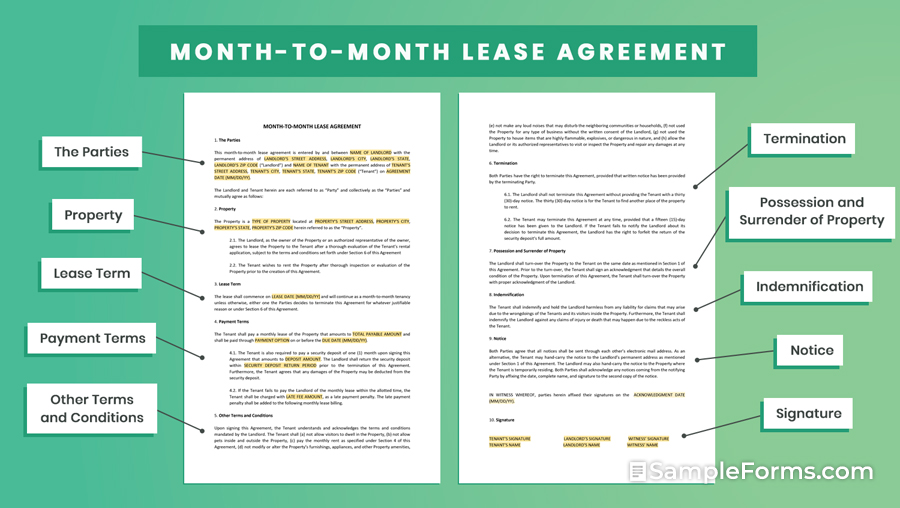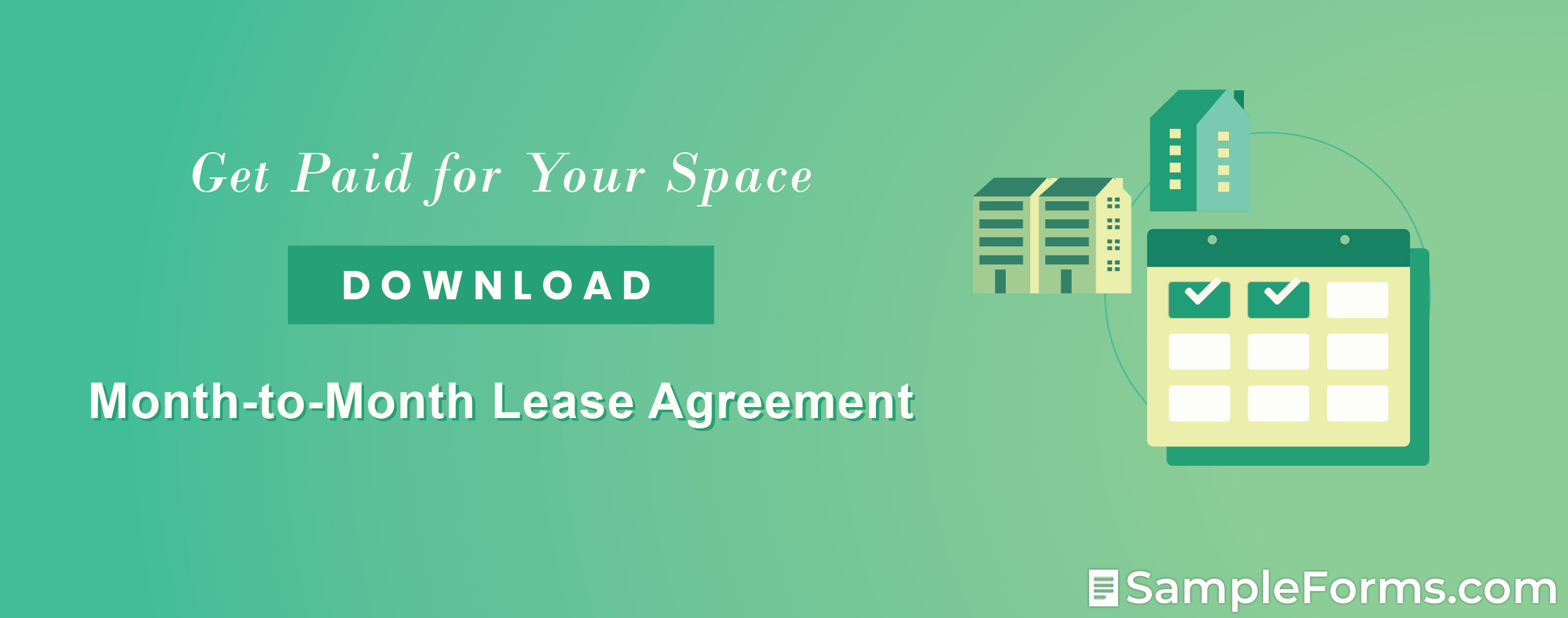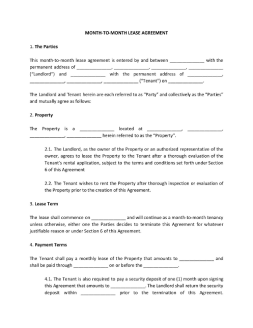- Eviction Notice Forms
- Power of Attorney Forms Forms
- Bill of Sale (Purchase Agreement) Forms
- Lease Agreement Forms
- Rental Application Forms
- Living Will Forms Forms
- Recommendation Letters Forms
- Resignation Letters Forms
- Release of Liability Agreement Forms
- Promissory Note Forms
- LLC Operating Agreement Forms
- Deed of Sale Forms
- Consent Form Forms
- Support Affidavit Forms
- Paternity Affidavit Forms
- Marital Affidavit Forms
- Financial Affidavit Forms
- Residential Affidavit Forms
- Affidavit of Identity Forms
- Affidavit of Title Forms
- Employment Affidavit Forms
- Affidavit of Loss Forms
- Gift Affidavit Forms
- Small Estate Affidavit Forms
- Service Affidavit Forms
- Heirship Affidavit Forms
- Survivorship Affidavit Forms
- Desistance Affidavit Forms
- Discrepancy Affidavit Forms
- Guardianship Affidavit Forms
- Undertaking Affidavit Forms
- General Affidavit Forms
- Affidavit of Death Forms
Month-to-Month Lease Agreement
The option of leasing a property is a popular choice among those who prefer particular living situations, such as living in high rise apartment towers. In these situations, there are individuals who are unsure of how long they would want to stay in that property. This indecisiveness increased the need for a month-to-month option in a lease arrangement. Rather than being confined in the property for a specific time frame, the tenant can choose to continue the arrangement for the next month or terminate it. Read More
Month-to-Month Lease Agreement
What Is a Month-to-Month Lease Agreement?

A month-to-month lease agreement is similar to a standard lease agreement with a significant difference when it comes to the term of the lease. This type of agreement is also coined rightfully as a tenancy at will. But, make sure to take note of your state’s existing laws regarding a month-to-month lease arrangement. Some states require the tenant to stay in the property within a minimum number of months before they have the option to discontinue the agreement for the next month.
How Do You Write a Month-to-Month Lease Agreement?
Creating a lease agreement can be a meticulous task because of the number of conditions that need to be considered. From the introduction down to specifying each essential condition, it can be a difficult task for anyone without prior experience of making it. But, with ready-made month-to-month lease agreement forms, you only need to supply it with the necessary details to tailor-fit the document to your situation.
1. Identify the Parties
It is of topmost priority to ensure that the parties involved in the agreement are appropriately introduced at the beginning of the agreement. The names of the parties are disclosed, as well as their designations or roles in the arrangement. As the document continues, each party will be referred to as their respective role. The introduction is closed with the statement saying that both parties are in agreement of pushing through with the lease.
2. Describe the Property
As both parties are in agreement, the specifications of the property are introduced and labeled as the property. The specification often calls for the type of property and its exact location. Supporting stipulations state that the landlord allowed the lease after a thorough examination of the lessee’s application. It also states that the tenant examined the condition of the property and is amenable in living in the property.
3. Discuss the Lease and Payment Terms
The nature of the lease goes hand in hand with its payment terms. Since this form is particularly for month-to-month lease arrangements, the discussion of the lease term is reasonably short. Similar to fixed-term arrangements, the rental fee is due on a particular day for each month. Indicate decisions regarding the preferred payment method, security deposit, and late fee dues. As for the security deposit, it is important to highlight if it can be channeled as payment for the last month’s rent or not. If not, include the detail of when the security deposit will be returned to the tenant. The period may vary from one state to another.
4. Review the Supporting Terms and Condition
The supporting terms and conditions of the form comprise almost half of the entire agreement and understandably so. A lease agreement is a collection of guidelines and lists of each parties’ responsibilities to one another. These other terms and conditions cover the following mandates: rules about having visitors over, rules about owning a pet, modifying or altering the utilities or furniture of the place, noise control, and other uses of the property. The conditions regarding the entry to make repairs or any maintenance measures are also present. Terms regarding the possession and surrender of property, indemnification, and notices should be in the latter part of the form. So, make sure to read the entire form from beginning to end.
5. Be Clear With the Termination Terms
For those who are not familiar with the month-to-month arrangement, the terms regarding the termination can be confusing. Thus, it is important to be clear in stating how to terminate the agreement. In this lease agreement form, if the landlord wishes to terminate the arrangement, a 30-day notice must be given to the tenant. Once the tenant receives this notice, they must start looking for another place to live in. On the other hand, if the tenant chooses to discontinue the deal, a 15-day notice is needed.
FAQs
What are the advantages of a month-to-month lease?
A month-to-month lease provides both flexibility and control to the tenant. The arrangement is flexible enough for a tenant who is yet to decide regarding the length of their stay. On the other hand, control is practiced on knowing until when the tenant is capable of renting the place.
What if the tenant refuses to honor the landlord’s eviction notice?
One disadvantage of month-to-month leases for landlords is the more complicated process of evicting a tenant. To do so, they need to send a notice 30 days before the date that they want the tenant to move out. But when the tenant refuses to honor this notice, the landlord can file for an eviction lawsuit, which can be burdensome for both parties.
Can a tenant get off the lease without a notice?
Other methods can evict a tenant from the leased property without assigning a lease. One way is if both parties have a mutual agreement and consent. The tenant can also be subjected to eviction from the property due to a serious breach of the agreement.
What happens when the tenant fails to send a notice?
If the tenant fails to send a notice of termination to the landlord on or before the 15th day before the eviction date, they are expected and obligated to pay the rent for the next month.
Where is a month-to-month lease mostly used?
Month to month leases or tenancy at will arrangements are most common among residential leases.

